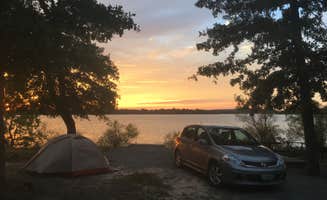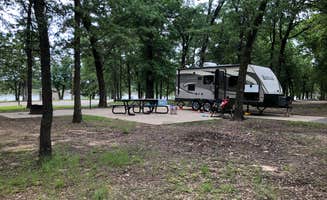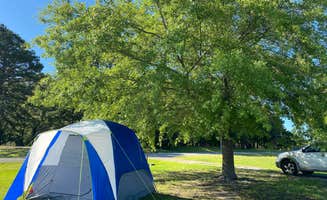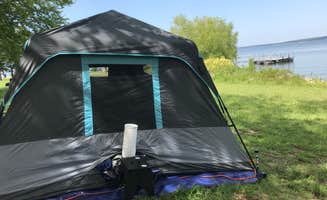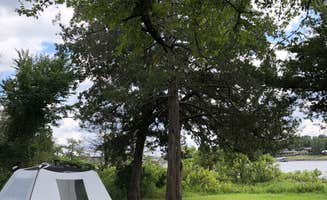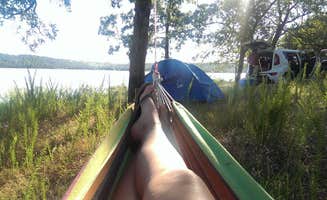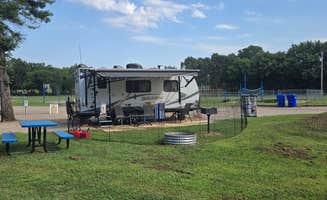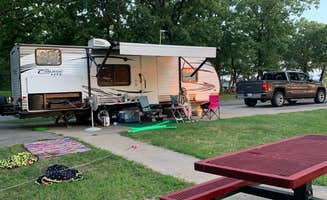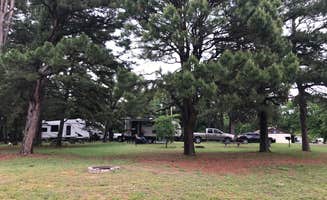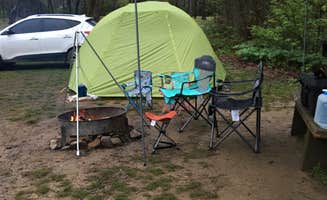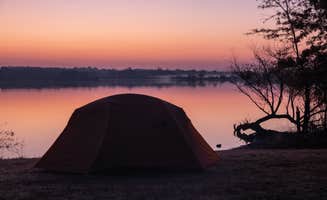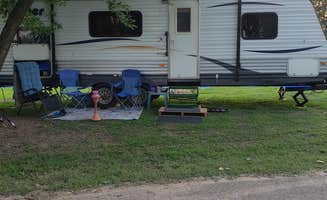Lake Eufaula spans over 102,000 acres across eastern Oklahoma, featuring 800 miles of shoreline and red clay beaches characteristic of the region. The lake sits at 585 feet above sea level and experiences hot summers with temperatures regularly reaching the mid-90s in July and August. Most Eufaula Lake campgrounds operate on a gated schedule with entry prohibited between 10 pm and 6 am during peak season.
What to do
Wildlife viewing opportunities: The Eufaula area supports diverse wildlife populations throughout the year. At Arrowhead State Park, visitors can spot deer wandering through campsites. One camper noted that at Belle Starr Park they "saw plenty of deer and an armadillo or two. Squirrels were plentiful as well."
Fishing from shore: Multiple campgrounds offer direct shoreline fishing access without needing a boat. According to a camper at Ladybird Landing, "This lake was so much fun, especially for canoeing and kayaking, this place had quite a bit of fish, as well as awesome bird watching!" Some campgrounds have fish cleaning stations for processing your catch.
Swimming at designated beaches: Several campgrounds maintain sandy swimming areas with gradual entries suitable for wading. A visitor at Brooken Cove mentioned "There are several sandy beach areas and the water is shallow for a great distance out, making it good for swimming." The beaches tend to be rockier and have red clay characteristics compared to white sand beaches found elsewhere.
Hiking trails: While not extensive, the area offers several hiking paths through wooded terrain. A visitor to Robbers Cave State Park shared: "The last thing we did before leaving Robbers Cave State Park after our three night stay was to go and search for the outlaws in the cave ourselves... It is a ¾ of a mile trail that my son absolutely loved."
What campers like
Spacious, well-separated sites: Most campgrounds around Lake Eufaula offer ample space between sites compared to more crowded destinations. A camper at Brooken Cove Campground observed "Nice campsites with room between sites. Most sites have lake views and there is a lot of access to the lake." This spacing provides privacy even during busy summer weekends.
Clean, accessible restrooms: While facilities vary by location, several campgrounds maintain well-kept bathroom buildings. At Deep Fork Campground, a visitor noted, "The bathrooms are not new but clean (and very hot during this stay). There are clean pay showers attached to the backside of the restroom." Shower costs typically range from $0.25 for 1-2 minutes to $1 for 6-8 minutes.
Paved camping pads: Many campsites feature concrete or asphalt pads that remain level even after heavy rains. A reviewer at Dogwood Campground shared, "Coming in to the park, there are scattered and very private campsites. At the end of the loop campsites are very close together, but have easy access to the restroom and showers."
Fall camping conditions: The autumn months provide excellent camping weather with reduced crowds. A camper noted, "October 7-9 we stayed in Dogwood campground spot number 81. We had a wonderful time and the weather was simply great. Colors were starting to change. Very clean campground and restrooms were very well maintained."
What you should know
Train noise affects some campgrounds: Depending on location, railroad noise can disrupt sleep at certain campgrounds. One camper reported, "The campground itself was pretty quiet but about every hour or so we heard a train horn. Which was loud and excessive. Like not one short 'choooooo' but more like a 'choooo chooo chooochoochoooo' for more than 10-15s, all throughout the night."
Wildlife encounters: Local wildlife frequently visits campgrounds, requiring food storage precautions. A visitor at Dogwood Campground observed "Plenty of trees, squirrels, birds, and a few deer" at their site. Insects can be problematic during warmer months, with one camper at Porum Landing warning: "Suggest checking your site before parking and if you have an ant system in place activate it. By the time we left I thought the ants planned to carry away our small cabin."
Water spigot locations vary: At many campgrounds, water hookups may require extra equipment. A camper at Belle Starr noted their "water hook up is a distance from the site. I had to use 2 hoses to reach my RV and only after I turned it around so that the water hook up side was closer to the spigot." Bringing 50-100 feet of hose ensures access to water regardless of spigot placement.
Off-season facility closures: Bathrooms and showers may close during winter months without notice. One visitor shared, "I would have given this a 5 plus star review, however, when we booked it they failed to tell us the bathrooms and showers had been locked for the season! Would have been good information to know considering we were in a pop up. Lots of peeing in the woods and driving to town."
Tips for camping with families
Playground facilities: Several campgrounds maintain play areas for children. A visitor to Highway 9 Landing noted, "Great playground for kids, clean bathrooms with showers. There are several sandy beach areas and the water is shallow for a great distance out, making it good for swimming." Some playgrounds need maintenance—check equipment before allowing children to play.
Nature programs: Some campgrounds offer ranger-led activities during peak season. A visitor to Turkey Flat Campground shared, "Spacious and paved pads with nature all around. Bathrooms were clean and showers excellent. This place is a real cost performer for outdoor activities!"
Cave exploration with kids: Robbers Cave provides a unique hiking experience for families with older children. A parent advised: "I will give you a spoiler alert, the hiking trail to the cave is steep and rocky with big drop-offs, so be careful with small children. It is a ¾ of a mile trail that my son absolutely loved. He was trying to find the robber that was hiding out. The hike was worth every hair raising nervous parent moment."
Wildlife viewing for kids: The various campgrounds offer opportunities for children to observe wildlife safely. One camper mentioned, "Saw plenty of deer and an armadillo or two. Squirrels were plentiful as well." Morning and evening hours typically provide the best wildlife viewing opportunities.


